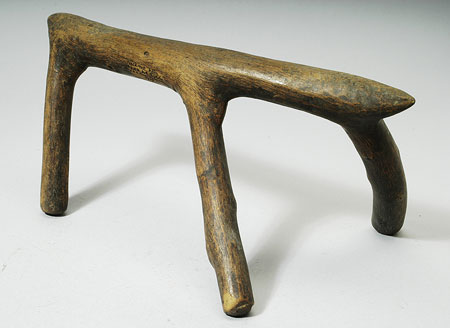Accession Number:
1937.34.49
Country:
Sudan
Region:
[Southern Sudan]
Cultural Group:
Nuer
Date Made:
By 1936
Materials:
Wood Plant
Process:
Carved , Stained , Polished
Dimensions:
Ht = 178, seat L = 394, W = 45.3, th = 39.5, leg diam = 25 to 29 mm [RTS 2/6/2005].
Weight:
665.7 g
Local Name:
köm
Other Owners:
Collected by Edward Evan Evans-Pritchard during his last period of fieldwork amongst the Nuer between October and November 1936, where he worked amongst the Nuer Leek in the area west of the Nile [RTS 6/7/2004].
Field Collector:
Edward Evan Evans-Pritchard
PRM Source:
Edward Evan Evans-Pritchard
Acquired:
Donated 1937
Collected Date:
October to November 1936
Description:
Headrest carved from a single piece of yellow wood, stained a yellowish brown colour throughout (Pantone 729C).
This is an example of 'found form', with a naturally grown branch specifically chosen because its shape, with subsidiary branches coming off the main stem to form the three feet, was suitable for making a headrest.
It consists of a narrow horizontal seat across the top, carved to a blunt point at either end, slightly convex across the top and more markedly so across its underside, and curving along its length.
Three narrower branches extend from the underside to form the legs, with 2 adjacent legs sloping down and out in alignment with one another, and the third leg splaying out in the opposite direction at the end.
The base of each leg is rounded, but has a worn patch on the surface where it has rested against the ground.
The headrest is complete and intact, with a weight of 665.7 grams and a height of 178 mm.
The seat is 394 mm long, 45.3 mm wide and 39.5 mm thick; the legs have a diameter of between 25 and 29 mm each.
This object was collected by Edward Evan Evans-Pritchard's during his last period of fieldwork amongst the Nuer (see E.E. Evans-Pritchard, 1940, The Nuer ).
Objects like these were used by men to protect their elaborate hairstyles. Willis described the Nuer practice of covering their hair with a paste made of clay, cow dung and urine, and then shaping it into the desired style, such as a cock's comb, or a peak at front or back. This treatment gradually wears off, staining the hair a reddish colour, and then the hair needs to be redone. Domville-Fife describes a similar process for the Shilluk in some detail, although amongst that group hair is dressed by a specialist barber, and is a costly process (C.W. Domville Fife, 1927, Savage Life in the Black Sudan, pp 71-76).
Evans-Pritchard gives the local term for this type of object as köm; note that he uses the same term for an Anuak headrest (see 1936.10.55-6). This type of lightweight headrest, made from a tree branch, is made by a number of Nilotic groups; for further Nuer examples, see 1917.25.39-40, 1931.66.17-18, 1932.30.2, 1936.10.56, 1948.2.128; for Dinka examples, see 1934.8.17, and for examples from the Anuak, see 1936.10.55.
Rachael Sparks 22/08/2005.
This object was collected by Edward Evan Evans-Pritchard's during his last period of fieldwork amongst the Nuer (see E.E. Evans-Pritchard, 1940, The Nuer ).
Objects like these were used by men to protect their elaborate hairstyles. Willis described the Nuer practice of covering their hair with a paste made of clay, cow dung and urine, and then shaping it into the desired style, such as a cock's comb, or a peak at front or back. This treatment gradually wears off, staining the hair a reddish colour, and then the hair needs to be redone. Domville-Fife describes a similar process for the Shilluk in some detail, although amongst that group hair is dressed by a specialist barber, and is a costly process (C.W. Domville Fife, 1927, Savage Life in the Black Sudan, pp 71-76).
Evans-Pritchard gives the local term for this type of object as köm; note that he uses the same term for an Anuak headrest (see 1936.10.55-6). This type of lightweight headrest, made from a tree branch, is made by a number of Nilotic groups; for further Nuer examples, see 1917.25.39-40, 1931.66.17-18, 1932.30.2, 1936.10.56, 1948.2.128; for Dinka examples, see 1934.8.17, and for examples from the Anuak, see 1936.10.55.
Rachael Sparks 22/08/2005.
Primary Documentation:
Accession Book Entry
[p.
38, pencil in left column] 34 [ink]
E.E.
EVANS-PRITCHARD
, M.A., Exeter College.
Specimens collected by himself in the EASTERN SUDAN, vis: [addition in different pen] (Coll.
in 1936) [p.
42] - From the NUER tribe, A[NGLO]-E[GYPTIAN].
SUDAN, viz: [pencil] 49 [ink] -
Köm
, three-legged neck-rest, cut from union of branches.
Card Catalogue Entry - There is no further information on the tribes catalogue card [RTS 23/7/2004].
Pitt Rivers Museum label - AFRICA, Sudan, Nuer tribe. Wooden headrest, local name köm. Coll. E.E. Evans-Pritchard, don. 1937. 1937.34.49 [plastic coated label, tied to object; RTS 31/5/2005].
Written on object - Neck-rest, köm, NUER, A.-E. SUDAN. d.d. E. Evans-Pritchard 1937 [RTS 31/5/2005].
Card Catalogue Entry - There is no further information on the tribes catalogue card [RTS 23/7/2004].
Pitt Rivers Museum label - AFRICA, Sudan, Nuer tribe. Wooden headrest, local name köm. Coll. E.E. Evans-Pritchard, don. 1937. 1937.34.49 [plastic coated label, tied to object; RTS 31/5/2005].
Written on object - Neck-rest, köm, NUER, A.-E. SUDAN. d.d. E. Evans-Pritchard 1937 [RTS 31/5/2005].




